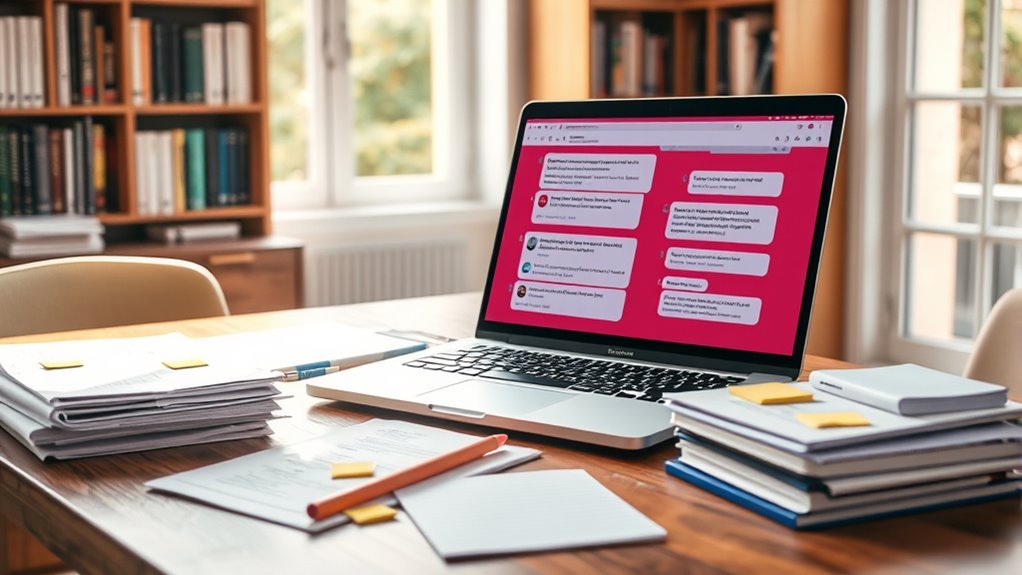To write effective prompts for debugging code with ChatGPT, be clear and concise. Start by identifying specific issues and break down your code into manageable sections. Provide relevant context and include specific code snippets that illustrate your problem. Formulate targeted questions to clarify confusion, like “Why does this function return null?”. Iteratively refine your inquiries based on responses to enhance accuracy. Following this structured approach can lead you to better insights and solutions. There’s much more to discover.
Understanding the Basics of Effective Prompting
When you’re looking to write effective prompts for debugging code, it’s essential to grasp the fundamentals of how they function. Effective communication hinges on prompt clarity, ensuring your questions are direct and unambiguous. Start by defining the problem succinctly; vague prompts lead to vague responses. Focus on specific components or errors in your code, as this narrows down the context. Remember, a well-structured prompt not only guides the response but also empowers you to explore solutions freely. Analyzing your approach to prompt creation can reveal deeper insights, ultimately enhancing your debugging process and fostering greater understanding.
Identifying the Specific Problem in Your Code
Understanding how to craft effective prompts lays the groundwork for identifying specific problems in your code. Start with error identification; pinpoint the exact issue before diving into debugging techniques. Break your code into smaller sections and isolate problems systematically. Use assertions or logging to capture unexpected behaviors, as these provide insights into where things go awry. Ask yourself targeted questions about the functionality and expected outcomes. This methodical approach not only clarifies the issue but also empowers you to communicate it effectively. By mastering these techniques, you’ll enhance your coding freedom and streamline your debugging process.
Providing Context and Code Snippets
To effectively debug your code, providing context and relevant code snippets is essential, as this information allows others to grasp the problem more quickly. Start by ensuring contextual relevance; describe the environment and any dependencies that might impact your code. Include snippets that highlight the specific area where the issue arises, emphasizing code clarity. This approach not only streamlines communication but also helps others understand the nuances of your problem. By offering clear context and well-structured code, you empower others to provide more targeted assistance, ultimately fostering a collaborative debugging experience that respects your pursuit of freedom in programming.
Asking Targeted Questions for Clarity
How can you guarantee that your questions lead to more effective debugging? By formulating targeted inquiries, you can enhance clarity and streamline the troubleshooting process. Focus on specific elements of the code that confuse you, rather than asking broad questions. For example, instead of asking, “What’s wrong with my code?” try, “Why does this function return null when it should return a value?” This precision directs attention to the core issue, facilitating a more meaningful dialogue. Remember, the more specific you are, the easier it is to identify solutions, ultimately granting you the freedom to solve problems efficiently.
Utilizing Examples to Illustrate Your Issue
Providing concrete examples can greatly enhance your ability to communicate the nuances of your coding issue. When you illustrate your problem, it’s essential to present clear example scenarios and code comparisons. Here are three effective ways to do that:
- Show the code: Include snippets that demonstrate the specific problem.
- Detail the environment: Describe the context in which the issue arises, like programming language or framework.
- Explain the expected vs. actual results: Clarify what you anticipated versus what occurred, highlighting discrepancies.
These steps can lead to more accurate and tailored assistance in resolving your coding difficulties.
Iterating on Responses for Better Results
When you receive a response to your debugging prompt, it’s essential to analyze its effectiveness. Refining your questions can lead to more targeted answers, while testing different approaches may uncover solutions you hadn’t considered. By iterating on your prompts, you enhance the likelihood of obtaining the insights necessary to resolve your coding challenges.
Refining Your Questions
Why settle for vague questions when refining your queries can lead to more precise debugging insights? By enhancing prompt clarity and question specificity, you can achieve better outcomes. Consider these steps:
- Define the Problem: Clearly articulate the issue you’re facing to eliminate ambiguity.
- Ask Open-Ended Questions: Encourage detailed responses that can provide deeper insights into the error.
- Iterate Based on Feedback: Refine your questions based on the answers you receive, ensuring you’re steering the conversation effectively.
Testing Different Approaches
Testing different approaches is essential for refining your debugging process, as it allows you to assess various solutions and identify the most effective one. By implementing diverse debugging techniques, you can uncover hidden issues and evaluate the efficiency of different troubleshooting strategies. Experimenting with multiple prompts can yield unexpected insights, helping you iterate on responses. Don’t hesitate to modify your queries or adjust parameters; this flexibility fosters creative problem-solving. Analyze the results systematically, focusing on what works best. Remember, each iteration brings you closer to a resolution, empowering you to tackle code issues with confidence and clarity.
Learning From the Solutions Provided
Although you might encounter various solutions for debugging code, understanding the rationale behind each approach is essential for your development as a programmer. Analyzing solution variations not only enhances your coding skills but also fosters a deeper comprehension of effective feedback implementation. Here are three key benefits of learning from provided solutions:
- Identifying Patterns: Recognizing common strategies can streamline your problem-solving process.
- Enhancing Flexibility: Adapting different approaches allows you to tackle diverse coding challenges.
- Building Confidence: Understanding various solutions empowers you to debug more effectively and independently.
Embrace these insights to grow as a programmer.



